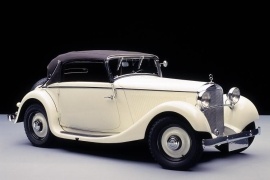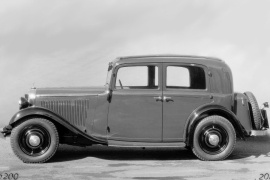MERCEDES BENZ Typ 200 Models/Series Timeline, Specifications & Photos
First production year: 1933
Engines: Gasoline
The German economy started to rise again after the great depression in the early '30s, and Mercedes-Benz moved quickly by launching the Typ 200 (W21) lineup on the market.
The German automaker didn't have, or didn't want, to involve too many resources in developing a new car from the ground up. So, instead, it took the already existing Typ 170 (W15), which was the first Mercedes-Benz with independent suspension in all corners, and improved it in any possible way. As a result, the Typ 200 was launched in 1933 with a few options for bodywork, including a small-sized, nimble convertible named Cabriolet A.
It was a clear evolution in terms of design above the Typ 170. It featured curved shapes and rounded edges, which were more expensive to build than the flat panels on the W15. But people liked it, and the car was more luxurious. Its long, curved front fenders were continued on the sides by the steps for easier ingress and egress to the vehicle. At the back, the raked-forward shape was more elegant than on its sedan sibling, which led to a smaller cabin.
Access was made via rear-hinged (suicide) doors on two seats. The dashboard was similar to its sedan sibling with a four-spoke steering wheel and center-mounted dials. Its floor-mounted gear stick was the only obstacle between the seats. At the same time, the removable canvas roof could have been folded behind the seats.
Under the hood, the carmaker installed its new 2.0-liter six-cylinder powerplant. However, it provided a mere 40 hp, just 8 hp more than on the Typ 170, that was sent to the rear wheels via a four-speed manual transmission.
With the economic trend rising again after the Great Depression that followed after the Wall Street Crash in 1929, Mercedes-Benz developed a new line of products for those who were already making money.
While the Mercedes-Benz Typ 170 was already on the market since 1931, the carmaker decided that it needed a revised model, obviously more expensive and more capable of satisfying customers' needs and desires. Thus, in 1933, the German company introduced the Typ 200.
The new model was clearly linked to its predecessor. Still, the most striking difference was the longer engine compartment that accommodated an inline-six instead of a four-pot mill. Moreover, the bodywork featured rounded edges instead of the cheaper to built hard corners from the Typ 170. But even in those hard times, Mercedes-Benz tried and managed to keep a design language. At the front, the headlights were still installed on a curved crossbar mounted between the front fenders. Its curved, long front fenders were stretched to the door sills and, depending on the version, sported the side-mounted spare wheels. These were placed behind the vehicle on the trunk for the short-wheelbase versions.
The interior was also upgraded with better materials. It was not just about using leather and wood trims, but the materials' quality, which was higher than on the Typ 170. But, to show a connection with its predecessor, the Typ 200 featured the same door opening system, with rear-hinged back doors.
Under the hood, the carmaker installed its new 2.0-liter six-cylinder powerplant. However, it provided a mere 40 hp, just 8 hp more than on the Typ 170, that was sent to the rear wheels via a four-speed manual transmission.

